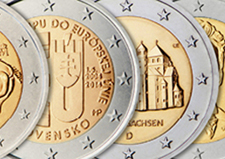The other side of the (euro) coin: Commemorative designs united in diversity

date: 01/03/2018
What do Rodin, Giotto, Saint Mark’s Basilica in Venice and Finland’s independence have in common? They were all the subject of commemorative euro coins last year. Euro area countries have been issuing such coins since 2004, and they often commemorate historical events, famous personalities or heritage sites. Euro coins are a good example of combining European unity and diversity. When deciding on their look, the Council agreed that they would have a common design on one side, and distinctive national symbols on the other. It was a way to ensure enough consistency while accommodating national traditions. Unlike banknotes, which are the competence of the European Central Bank, euro coins are still a national competence. And through the years, the designs on the national side have evolved – when the Head of State changes, for instance. Such was the case in Belgium, where the coins have shown King Philippe since 2014, and Spain, which introduced the portrait of King Felipe VI in 2015. Together with these national specificities, since 2004 countries can also issue commemorative series, which are legal tender and add to the existing variety of euros.
